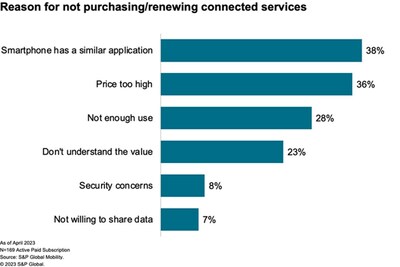S&P Global Mobility: What Connected Car Services are Consumers Willing to Pay For?
Car-shoppers are largely satisfied with subscription-based infotainment services, but value and exposure matter most. Data security and privacy remain issues.
But here's the rub: The perceived outrage doesn't match reality. Once consumers experience connected services, they are overwhelmingly satisfied and likely to resubscribe, according to a recent global consumer survey of nearly 8,000 consumers conducted by S&P Global Mobility.
"Consumers are welcoming to the idea of subscriptions, because it gives them exposure to features or technology that they may not have had in the past," said Yanina Mills, senior technical research analyst at S&P Global Mobility.
In a subset of about 4,500 respondents who had experienced a free trial or an existing subscription on a model year 2016 vehicle or newer,
Exposure sells subscriptions
Fumbled introductions are one thing. Selling subscriptions in the here and now is another. More than one in four respondents -
In-vehicle exposure is even better than education for growing demand and fostering satisfaction and retention with these services and brands.
That's because, once exposed, consumers are pretty happy with their connected services subscriptions. The vast majority of previous-subscriber respondents said they were likely to renew. Satisfaction is high as well, as
So, how could OEMs do better in rolling out new connected ideas? When it comes to subscription-based connected services, Mills says, "Marketing is everything. Implementation is everything."
In GM's case, they touted the benefits of their new infotainment system, to be found in its next generation of EVs. According to the automaker, GM wishes to "manage the overall in-vehicle experience in a more holistic way." A major goal is to "reduce complexity and feature duplication," eliminating the redundancy between native onboard infotainment and the customer's smartphone.
But that came with a big tradeoff: Getting rid of the Apple CarPlay and Android Auto user interfaces. The media focused on that detail, in terms of erasing any of the new infotainment system's advantages. After all, these very popular smartphone mirroring apps come standard on almost every new vehicle today.
Fanni Li, connected car services research lead at S&P Global Mobility, says that GM is quite aggressive in this area, but warns that making the change could risk GM customer satisfaction. Also at stake: GM's desire to generate
Subscriptions need to add value
So, how to get it right? Paid functional upgrades have been available in the market for only about three years. Despite that short timeframe, more than half of respondents already want such an upgrade in their next vehicle.
But not all subscription-based upgrades are created equal. Enhanced navigation and advanced driver-assist system (ADAS) functionality top the desirability list. "For a lot of those features, when you buy them in full at the dealership, the initial investment is overwhelming," according to Mills. A subscription brings their cost into reach.
As seen in previous S&P Global Mobility consumer surveys, safety features prove very popular – although there are differences in appeal by region. For instance, at a country level,
But there are some pan-global trends worthy of note. Paid upgrade safety features, such as high-beam assist and driving-video recorder, earned the highest satisfaction –
Less expensive comfort features, such as heated seats and a heated steering wheel, prove less popular for subscriptions. Compared to more novel and higher-priced technology features, these less-expensive options have less perceived value when structured as a subscription – especially when they have long been available as standard on upper-trim models. As Mills notes, "When everything becomes a subscription, it becomes overkill."
Getting heated over seats
BMW may have crossed that line with their expansion of connected services. Many observers boiled down the complex model- and market-specific program to one common theme -- surprisingly charging owners to use heated seats that were already installed in their cars.
S&P Global Mobility survey data suggests, however, that this furor was a tempest in a teapot. Fewer than
"The frequency of usage is an important factor," Mills observed. "If you have a feature that you only use once or twice, you're not going to renew that feature." Using heated seats or a heated steering wheel is very climate-dependent, so usage can vary by season.
Smartphone vs Native
While ADAS functionality or heated seats can't be provided by smartphones, many infotainment services are. And consumers are accustomed to using their smartphone for navigation and entertainment features -- from maps to music to hands-free texting.
As consumers pare down their subscriptions, features that are redundant between the vehicle and the phone likely are the first to go -- and the smartphone almost always wins. S&P Mobility found that Gen Z and Millennial respondents are most likely to drop connected-services subscriptions because of similar services on their smartphones.
GM's elimination of Apple CarPlay and Android Auto takes the smartphone out of the equation. This could improve their odds of gaining and retaining subscriptions. But given that
"GM cannot get consumers' usage data from the infotainment system if users only connect via third party apps like Apple CarPlay and Android Auto," Li said. "Having this data on their own will become one of the competitive advantages for OEMs."
Privacy and Trust
But when it comes to vehicle data usage, Mills says, "It's a delicate balance for automakers." While accessing consumer data also improves features like EV-specific routing and range estimates, consumers are concerned about data privacy.
Turns out the best way to win over consumers is to give them something for free.
But who do consumers trust with their data? OEMs are the most trusted, with
In other words, your smartphone apps already know far more about you than your SUV likely ever will.
Subscription-based connected services provide great potential for OEMs. High consumer satisfaction and renewal rates show that buyers are willing to subscribe. But proper marketing and implementation are essential for success, especially regarding concerns of value and data privacy.
About S&P Global Mobility
At S&P Global Mobility, we provide invaluable insights derived from unmatched automotive data, enabling our customers to anticipate change and make decisions with conviction. Our expertise helps them to optimize their businesses, reach the right consumers, and shape the future of mobility. We open the door to automotive innovation, revealing the buying patterns of today and helping customers plan for the emerging technologies of tomorrow.
S&P Global Mobility is a division of S&P Global (NYSE: SPGI). S&P Global is the world's foremost provider of credit ratings, benchmarks, analytics and workflow solutions in the global capital, commodity, and automotive markets. With every one of our offerings, we help many of the world's leading organizations navigate the economic landscape so they can plan for tomorrow, today. For more information, visit www.spglobal.com/mobility.
(Disclosure: The survey was in the field in March - well after BMW had been involved in the heated-seat issue, but before GM had announced its plans for a new native architecture designed around offering connected car services.)
Media Contact:
Michelle Culver
S&P Global Mobility
248.728.7496 or 248.342.6211
Michelle.Culver@spglobal.com
![]() View original content to download multimedia:https://www.prnewswire.com/news-releases/sp-global-mobility-what-connected-car-services-are-consumers-willing-to-pay-for-301881290.html
View original content to download multimedia:https://www.prnewswire.com/news-releases/sp-global-mobility-what-connected-car-services-are-consumers-willing-to-pay-for-301881290.html
SOURCE S&P Global Mobility










